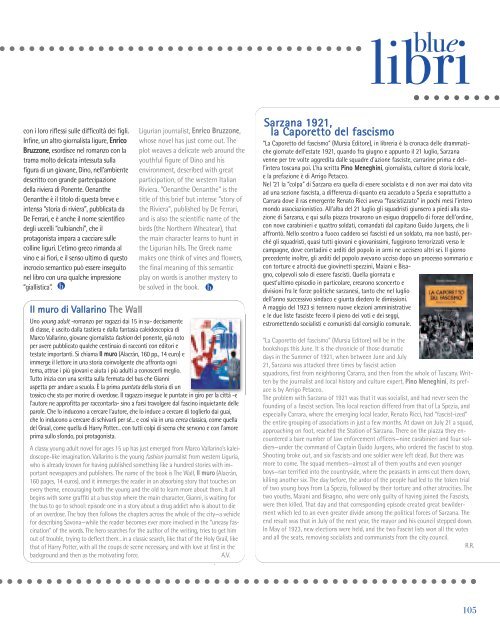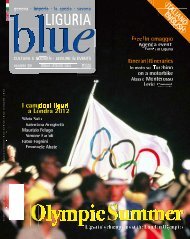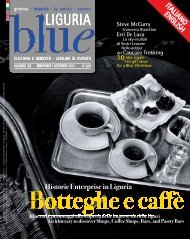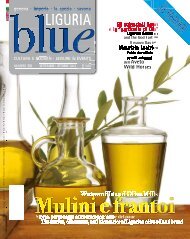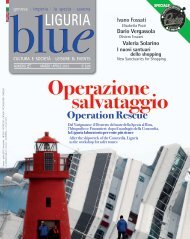Facciamoci sorprendere - Blue Liguria - Sagep
Facciamoci sorprendere - Blue Liguria - Sagep
Facciamoci sorprendere - Blue Liguria - Sagep
Create successful ePaper yourself
Turn your PDF publications into a flip-book with our unique Google optimized e-Paper software.
con i loro riflessi sulle difficoltà dei figli.<br />
Infine, un altro giornalista ligure, Enrico<br />
Bruzzone, esordisce nel romanzo con la<br />
trama molto delicata intessuta sulla<br />
figura di un giovane, Dino, nell’ambiente<br />
descritto con grande partecipazione<br />
della riviera di Ponente. Oenanthe<br />
Oenanthe è il titolo di questa breve e<br />
intensa “storia di riviera”, pubblicata da<br />
De Ferrari, e è anche il nome scientifico<br />
degli uccelli “culbianchi”, che il<br />
protagonista impara a cacciare sulle<br />
colline liguri. L’etimo greco rimanda al<br />
vino e ai fiori, e il senso ultimo di questo<br />
incrocio semantico può essere inseguito<br />
nel libro con una qualche impressione<br />
“giallistica”.<br />
Il muro di Vallarino The Wall<br />
<strong>Liguria</strong>n journalist, Enrico Bruzzone,<br />
whose novel has just come out. The<br />
plot weaves a delicate web around the<br />
youthful figure of Dino and his<br />
environment, described with great<br />
participation, of the western Italian<br />
Riviera. “Oenanthe Oenanthe” is the<br />
title of this brief but intense “story of<br />
the Riviera”, published by De Ferrari,<br />
and is also the scientific name of the<br />
birds (the Northern Wheatear), that<br />
the main character learns to hunt in<br />
the <strong>Liguria</strong>n hills. The Greek name<br />
makes one think of vines and flowers,<br />
the final meaning of this semantic<br />
play on words is another mystery to<br />
be solved in the book.<br />
Uno young adult -romanzo per ragazzi dai 15 in su- decisamente<br />
di classe, è uscito dalla tastiera e dalla fantasia caleidoscopica di<br />
Marco Vallarino, giovane giornalista fashion del ponente, già noto<br />
per avere pubblicato qualche centinaio di racconti con editori e<br />
testate importanti. Si chiama Il muro (Alacrán, 160 pp., 14 euro) e<br />
immerge il lettore in una storia coinvolgente che affronta ogni<br />
tema, attrae i più giovani e aiuta i più adulti a conoscerli meglio.<br />
Tutto inizia con una scritta sulla fermata del bus che Gianni<br />
aspetta per andare a scuola. È la prima puntata della storia di un<br />
tossico che sta per morire di overdose. Il ragazzo insegue le puntate in giro per la città -e<br />
l’autore ne approfitta per raccontarla- sino a farsi travolgere dal fascino inquietante delle<br />
parole. Che lo inducono a cercare l’autore, che lo induce a cercare di toglierlo dai guai,<br />
che lo inducono a cercare di schivarli per sé... e così via in una cerca classica, come quella<br />
del Graal, come quella di Harry Potter... con tutti colpi di scena che servono e con l’amore<br />
prima sullo sfondo, poi protagonista.<br />
A classy young adult novel for ages 15 up has just emerged from Marco Vallarino’s kaleidoscope-like<br />
imagination. Vallarino is the young fashion journalist from western <strong>Liguria</strong>,<br />
who is already known for having published something like a hundred stories with important<br />
newspapers and publishers. The name of the book is The Wall, Il muro (Alacrán,<br />
160 pages, 14 euros), and it immerges the reader in an absorbing story that touches on<br />
every theme, encouraging both the young and the old to learn more about them. It all<br />
begins with some graffiti at a bus stop where the main character, Gianni, is waiting for<br />
the bus to go to school: episode one in a story about a drug addict who is about to die<br />
of an overdose. The boy then follows the chapters across the whole of the city—a vehicle<br />
for describing Savona—while the reader becomes ever more involved in the “uneasy fascination”<br />
of the words. The hero searches for the author of the writing, tries to get him<br />
out of trouble, trying to deflect them…in a classic search, like that of the Holy Grail, like<br />
that of Harry Potter, with all the coups de scene necessary, and with love at first in the<br />
background and then as the motivating force. A.V.<br />
.<br />
Sarzana 1921,<br />
la Caporetto del fascismo<br />
libri<br />
blue<br />
“La Caporetto del fascismo” (Mursia Editore), in libreria è la cronaca delle drammatiche<br />
giornate dell’estate 1921, quando fra giugno e appunto il 21 luglio, Sarzana<br />
venne per tre volte aggredita dalle squadre d’azione fasciste, carrarine prima e dell’intera<br />
toscana poi. L’ha scritta Pino Meneghini, giornalista, cultore di storia locale,<br />
e la prefazione è di Arrigo Petacco.<br />
Nel ‘21 la “colpa” di Sarzana era quella di essere socialista e di non aver mai dato vita<br />
ad una sezione fascista, a differenza di quanto era accaduto a Spezia e soprattutto a<br />
Carrara dove il ras emergente Renato Ricci aveva “fascistizzato” in pochi mesi l’intero<br />
mondo associazionistico. All’alba del 21 luglio gli squadristi giunsero a piedi alla stazione<br />
di Sarzana, e qui sulla piazza trovarono un esiguo drappello di forze dell’ordine,<br />
con nove carabinieri e quattro soldati, comandati dal capitano Guido Jurgens, che li<br />
affrontò. Nello scontro a fuoco caddero sei fascisti ed un soldato, ma non bastò, perché<br />
gli squadristi, quasi tutti giovani e giovanissimi, fuggirono terrorizzati verso le<br />
campagne, dove contadini e arditi del popolo in armi ne uccisero altri sei. Il giorno<br />
precedente inoltre, gli arditi del popolo avevano ucciso dopo un processo sommario e<br />
con torture e atrocità due giovinetti spezzini, Maiani e Bisagno,<br />
colpevoli solo di essere fascisti. Quella giornata e<br />
quest’ultimo episodio in particolare, crearono sconcerto e<br />
divisioni fra le forze politiche sarzanesi, tanto che nel luglio<br />
dell’anno successivo sindaco e giunta diedero le dimissioni.<br />
A maggio del 1923 si tennero nuove elezioni amministrative<br />
e le due liste fasciste fecero il pieno dei voti e dei seggi,<br />
estromettendo socialisti e comunisti dal consiglio comunale.<br />
“La Caporetto del fascismo” (Mursia Editore) will be in the<br />
bookshops this June. It is the chronicle of those dramatic<br />
days in the Summer of 1921, when between June and July<br />
21, Sarzana was attacked three times by fascist action<br />
squadrons, first from neighboring Cararra, and then from the whole of Tuscany. Written<br />
by the journalist and local history and culture expert, Pino Meneghini, its preface<br />
is by Arrigo Petacco.<br />
The problem with Sarzana of 1921 was that it was socialist, and had never seen the<br />
founding of a fascist section. This local reaction differed from that of La Spezia, and<br />
especially Carrara, where the emerging local leader, Renato Ricci, had “fascist-ized”<br />
the entire grouping of associations in just a few months. At dawn on July 21 a squad,<br />
approaching on foot, reached the Station of Sarzana. There on the piazza they encountered<br />
a bare number of law enforcement officers—nine carabinieri and four soldiers—under<br />
the command of Captain Guido Jurgens, who ordered the fascist to stop.<br />
Shooting broke out, and six Fascists and one soldier were left dead. But there was<br />
more to come. The squad members—almost all of them youths and even younger<br />
boys—ran terrified into the countryside, where the peasants in arms cut them down,<br />
killing another six. The day before, the ardor of the people had led to the token trial<br />
of two young boys from La Spezia, followed by their torture and other atrocities. The<br />
two youths, Maiani and Bisagno, who were only guilty of having joined the Fascists,<br />
were then killed. That day and that corresponding episode created great bewilderment<br />
which led to an even greater divide among the political forces of Sarzana. The<br />
end result was that in July of the next year, the mayor and his council stepped down.<br />
In May of 1923, new elections were held, and the two Fascist lists won all the votes<br />
and all the seats, removing socialists and communists from the city council.<br />
R.R.<br />
105


